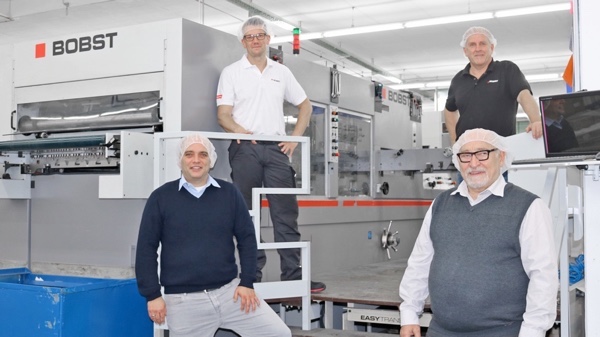Offset Printing
BOBST services for process optimization allow German packaging company Spiegel Verpackungen

Tuesday 24. November 2020 - More and more packaging manufacturers from around the word are using BOBSTs expert services for process optimization. For example, in 2017, the German company Martin Spiegel Kartonagenfabrik implemented a comprehensive optimization project supported by BOBST.
“Under increasing pressure from our competitors, it is more important than ever for us to produce cost-efficiently and to be in a position to offer packaging at competitive prices,” stated the company owner and Managing Director Michael Spiegel as he summarized the progress that has been achieved. “In close cooperation with experts from BOBST, we have been able to significantly increase the efficiency and stability of our production during the last two years. At the same time, we instigated a number of measures which simplified the work of the machine operators and improved their working environment.”
Continuous process optimization
“We are continuously discovering new options for how we, as a full-service service provider, can make the process even more attractive for our customers,” continued Spiegel. “In particular, the digitalization of the production processes is offering fascinating options for the future. So for us, an optimization project morphed into a continuous improvement process.”
There are three experts from Bobst Meerbusch engaged just on this project. They work hand in hand with Arnaud Jolliet, Product Development Specialist Business Unit Services at BOBSTs headquarters in Mex, Switzerland. The team engages further BOBST experts depending on the task involved. “The employees from Bobst Meerbusch have previously worked in packaging production and have a deep understanding of our situation and our processes. Their well-founded practical experience has helped immensely to quickly establish the specific measures we need and to get them implemented in a tailored manner,” stated Spiegel.
End-to-end optimization
The experts from BOBST first analyzed the production process from end-to-end. The main focus was on the die-cutters and the folder-gluers. This analysis was the basis for establishing the target goal for process optimization. For example, they defined the throughput per hour that manufactures of long-seam and crash-lock bottom boxes should be achieved in the future. Next, the team worked on optimization of the technical performance of the three flat-bed cutter-creasers and the four gluers. The operational abilities of the BOBST machines were optimized as a result of BOBSTs preventive maintenance service, Maintenance Plus.
In the die-cutting process, for example, the team adapted the specifications for the cutting dies as well as the size and positions of the stopping points in order to achieve higher approach speeds to the machines and to reduce the efforts required for reworking. Optimization of the work arrangement on the sheets minimized breakdown of the die-cutting. At the same time, the adaptations increased the service life of the punching tools. In addition to these measures the equipping processes were standardized.
This included replacing wear parts in the folder gluers, making repairs, correcting belt settings and optimizing the order control for the gluers as well as the organization of tool and wear parts according to the 5S method. There are equipping processes stored in the MATIC control for the machines to enable predominantly automatic manufacture of special packaging.
In addition, standardization of the pause regulation and the core working times as well as optimization of ergonomics in the packaging process increased the availability of the gluers. Folding carton designs were modified to make production simpler and more efficient. Standardized cleaning and maintenance processes were introduced both for the die-cutters and the gluers.
These optimizations created the technical prerequisites for maximizing the capacity of these machines. In order to actually realize the gains in productivity in day to day operations, Spiegel organized further training for the companys machine operators to obtain additional qualifications from BOBST. The training sessions took place on the machines at Spiegel Verpackungen.
The production planning was also completely restructured. Today the company is working according to the pull production principle, which has significantly increased the process efficiency. In addition, the interim storage area on the machines for semi-finished goods was significantly reduced.
All of these improvements have led to a paradigm shift in the company. “Now we are able to produce far more packaging on our machines in the same period of time,” said Spiegel. “We are therefore capable of handling our increased order volumes in just one shift.”
This work has been more than just a simple partnership
For both die-cutters and folder-gluers, BOBST has been the partner of choice for Spiegel for decades now. “We see BOBST as a premium brand,” he said. “It is also important for our customers that we put our trust in the highest quality and most productive technology. This process optimization has given BOBST the opportunity to emphasize its leadership one more time.”
With its new industry vision, BOBST is working to is shape a new reality where connectivity, digitalization, automation and sustainability are the cornerstones of packaging production. Similarly at Spiegel Verpackungen, there has been a shift to more environmentally friendly packaging materials as well as an increase in automation, as the company embraces Industry 4.0. Connected Services from BOBST will aid in this regard. Spiegel Verpackungen has already arranged for the purchasing of replacement parts for its BOBST machines to be conducted over the B2B portal MyBOBST, a standardized, simplified and transparent ordering process. The company is also considering implementation of the remote assistance service, Helpline Plus AR. This innovation provides a remote assistance service to BOBSTs customers using a smart headset with augmented reality glasses to enable technicians at BOBST view customer machines remotely through the eyes of the machine operator in the case of mechanical faults arising, and to issue remedial instructions.
